Experimental Study on Mechanical Properties of Root–Soil Composite Reinforced by MICP
Abstract
:1. Introduction
2. Materials and Methods
2.1. Root–Soil Composite
2.2. Bacteria and Growth Medium
2.3. Cementation Concentration
2.4. Sample Preparation
2.5. Experimental Instruments
3. Results
3.1. Shear Strength Analysis
3.2. Deformation Failure Analysis
3.3. SEM Analysis
4. Conclusions
- (1)
- MICP can improve the shear strength of undisturbed root–soil composites. Compared with the solidified ordinary cohesive soil, the strength increase is 110–140%, and the root system in the root–soil composite has a positive effect on the increase in its shear strength.
- (2)
- The higher the concentration of CaCl2 in the cementation solution, the more obvious the improvement of the shear strength of the root–soil composite, and the high concentration of calcium ions will promote the reaction and produce more calcium carbonate precipitation. Under the condition of constant urea and root content, when the concentration of CaCl2 in the cementation solution is 1 mol/L, the solidification effect of the root–soil composite is the best, but the increase in strength is the largest when the concentration is 0.75 mol/L.
- (3)
- After microbial reinforcement of the root–soil composite, the increase in cohesion is greater than that of the internal friction angle. In practical engineering applications, the strength parameters of the root–soil composite can be effectively improved by increasing the amount of calcium carbonate precipitation.
Author Contributions
Funding
Institutional Review Board Statement
Informed Consent Statement
Data Availability Statement
Conflicts of Interest
References
- Ge, R.L.; Zhang, C.F.; Meng, Z.J.; Si, Q.; Wu, Y.D. The Shear Property Comparison of Three Roots-soil Composites. J. Soil Water Conserv. 2014, 28, 85–90. [Google Scholar]
- Zhu, J.Q.; Wang, Y.Q.; Wang, Y.J.; Zhang, H.L.; Li, Y.P.; Liu, Y. Analysis of root system enhancing shear strength based on experiment and model. Rock Soil Mech. 2014, 35, 449–458. [Google Scholar]
- Qi, Z.; Yu, D.; Liu, Y.B.; Fu, J.T.; Hu, X.S.; Li, S.X.; Zhao, D. Experimental research on factors affecting shear strength of halophyte root-soil comp osite systems in cold and arid environments. Q. J. Eng. Geol. Hydroge 2017, 25, 1438–1448. [Google Scholar]
- Hu, Q.Z.; Zhou, Z.; Xiao, B.L.; Xiao, H.L. Experimental Research on Relationship Between Root Weight and Shearing Strength in Soil. Soil Eng. Foud. 2010, 24, 85–87. [Google Scholar]
- Whiffin, V.S.; Paassen, L.A.V.; Harkes, M.P. Microbial Carbonate Precipitation as a Soil Improvement Technique. Geomicrobiol. J. 2007, 24, 417–423. [Google Scholar] [CrossRef]
- Zhao, Q.; Li, L.; Li, C.; Li, M.D.; Amini, F. Factors affecting improvement of engineering properties of MICP-treated soil catalyzed by bacteria and urease. J. Mater. Civil Eng. 2014, 26, 04014094. [Google Scholar] [CrossRef]
- Soon, N.W.; Lee, L.M.; Khun, T.C.; Ling, H.S. Improvements in engineering properties of soils through microbial-induced calcite precipitation. KSCE J. Civil Eng. 2013, 17, 718–728. [Google Scholar] [CrossRef]
- Choi, S.G.; Chu, J.; Brown, R.C.; Wang, K.J.; Wen, Z.Y. Sustainable biocement production via microbially induced calcium carbonate precipitation: Use of limestone and acetic acid derived from pyrolysis of lignocellulosic biomass. ACS Sustain. Chem. Eng. 2017, 5, 5183–5190. [Google Scholar] [CrossRef]
- Harkes, M.P.; Van Paassen, L.A.; Booster, J.L.; Whiffin, V.S.; Loosdrecht, M.C.M. Fixation and distribution of bacterial activity in sand to induce carbonate precipitation for ground reinforcement. Ecol. Eng. 2010, 36, 112–117. [Google Scholar] [CrossRef]
- Chu, F.Z.; Wu, J.Y.; Ding, J.H.; Zhou, Y.D.; He, J.; Hang, L. Research progress on using biocement in liquefiable ground treatment. J. Water Res. Arch. Eng. 2019, 17, 91–96. [Google Scholar]
- Wu, C.C.; Zheng, J.J.; Lai, H.J.; Cui, M.J.; Song, Y. Experiental study of the strength enhancing mechanism of bio-cemented sand and its influential factors. J. Civil. Env. Eng. 2020, 42, 31–38. [Google Scholar]
- Li, J.; Fang, X.W.; Shen, C.N.; Ou, Y.X.; Zhang, N. Influence of Grain Composition on Coral Sand Bio-cementation. J. Water Resour. Arch. Eng. 2016, 14, 7–12+43. [Google Scholar]
- Peng, J.; Wen, Z.L.; Liu, Y.C.; Feng, Q.P.; He, J. Experimental research on MICP-treated organic clay. Chin. J. Geot. Eng. 2019, 41, 733–740. [Google Scholar]
- Shen, T.Y.; Wang, S.J.; Xue, L.; Li, X.; He, B.H. An experimental study of sandy clayey purple soil enhanced through microbial-induced calcite precipitation. Rock Soil Mech. 2019, 40, 3115–3124. [Google Scholar]
- Liu, L.; Shen, Y.; Liu, H.L.; Chu, J. Application of bio-cement in erosion control of levees. Rock Soil Mech. 2016, 37, 3410–3416. [Google Scholar]
- Ran, J.Y.; Wang, X.L.; Wang, Y.; Xiao, Y.; He, X.; Chu, J. Strength and stability of embankment foundation strengthened by MICP. J. Civil Env. Eng. 2018, 40, 128–134. [Google Scholar]
- Yang, C.C.; Zhu, L.S.; Li, D.Q.; Liu, H.; Gong, Z.W.; Jiang, N.; Liu, Y.Y. Effect of Different Amount of Bacillus subtilis on Nutrients of Tobacco Planting Soils. Southwest China J. Agri. Sci. 2018, 31, 779–785. [Google Scholar]
- Huang, W.; Mou, Y.Q.; Li, Y.; Zhao, B.Y.; Li, J.J.; Wu, X.H.; Zhou, M. Study on durability of MICP treated cohesive soils under dry-wet cycle and freeze-thaw cycle. Arab. J. Geosci. 2022, 15, 422. [Google Scholar] [CrossRef]
- Whiffin, V.S. Microbial CaCO3 Precipitation for the Production of Biocement. Ph.D. Thesis, Murdoch University, Perth, Australia, 2004. [Google Scholar]
- Smith, A.; Pritchard, M.; Edmondson, A.; Bashir, S. The Reduction of the Permeability of a Lateritic Soil through the Application of Microbially Induced Calcite Precipitation. Nat. Resour. 2017, 8, 337–352. [Google Scholar] [CrossRef] [Green Version]
- Cui, M.J.; Zheng, J.J.; Lai, H.J. Effect of method of biological injection on dynamic behavior for bio-cemented sand. Rock Soil Mech. 2017, 38, 3173–3178. [Google Scholar]
- Cheng, L.; Cord-Ruwisch, R. Upscaling effects of soil improvement by microbially induced calcite precipitation by surface percolation. Geomicrobiol. J. 2014, 31, 396–406. [Google Scholar] [CrossRef] [Green Version]
- Canakci, H.; Sidik, W.; Kilic, I.H. Effect of bacterial calcium carbonate precipitation on compressibility and shear strength of organic soil. Soils Found. 2015, 55, 1211–1221. [Google Scholar] [CrossRef] [Green Version]
- Shen, T.Y.; Li, X.; Wang, S.J.; Xu, C.; Xue, L. Triaxial shear strength and immersion compressive strength of sandy clayey purple soil treated by microbial induced calcite precipitation. Tra. Chin. Soci. Agri. Eng. 2019, 35, 135–143. [Google Scholar]
- Choi, S.G.; Chu, J.; Kwon, T.H. Effect of chemical concentrations on strength and crystal size of biocemented sand. Geomech. Eng. 2019, 17, 465–473. [Google Scholar]
- Yu, M.; Zhang, J.M.; Zhou, Y.; Sun, K.B. Experimental Study on Modifying Expansive Soil by MICP Technology. J. Yangtze River Sci. Res. Inst. 2021, 38, 103–108. [Google Scholar]
- Kadhim, F.J.; Zheng, J.J. Influences of calcium sources and type of sand on microbial induced carbonate precipitation. Int. J. Eng. Sci. 2017, 10, 20–29. [Google Scholar]
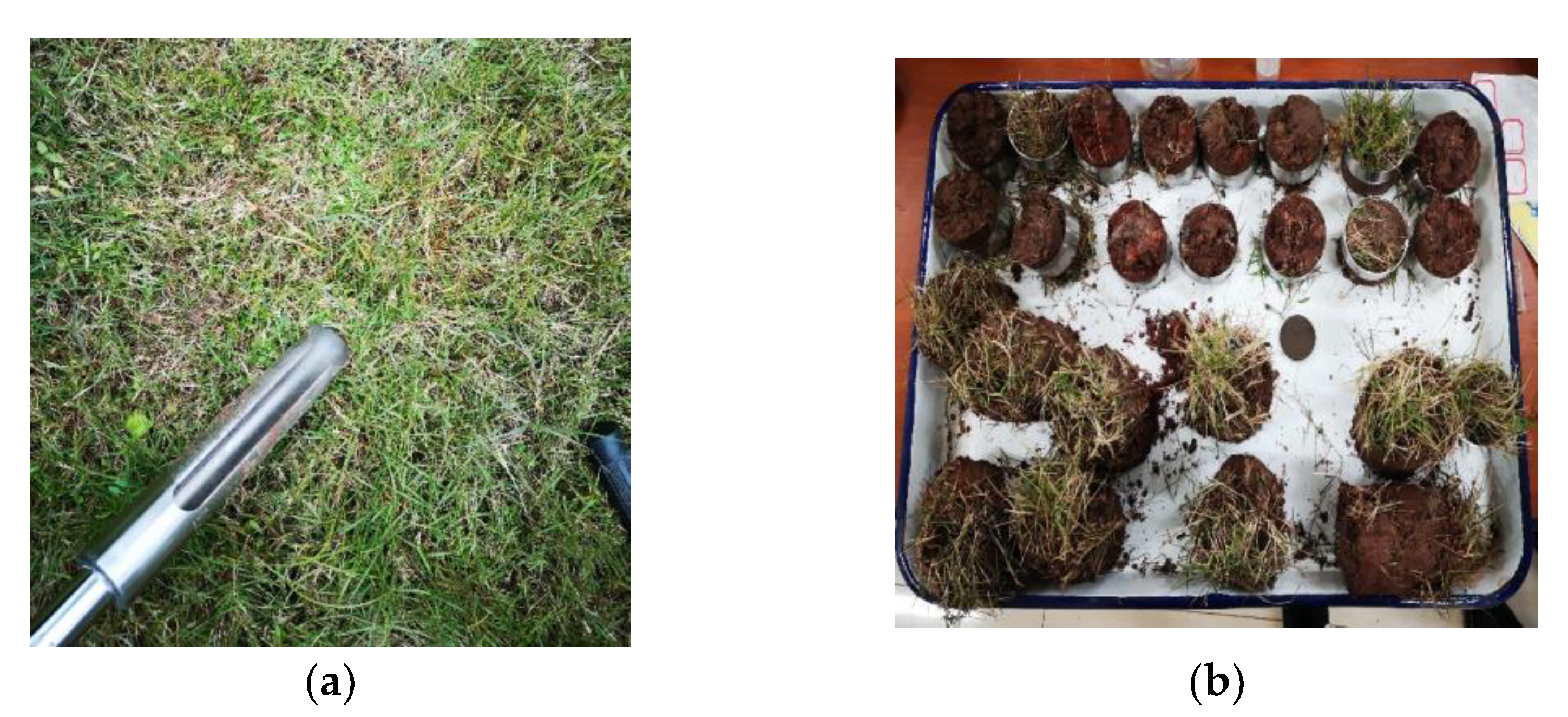
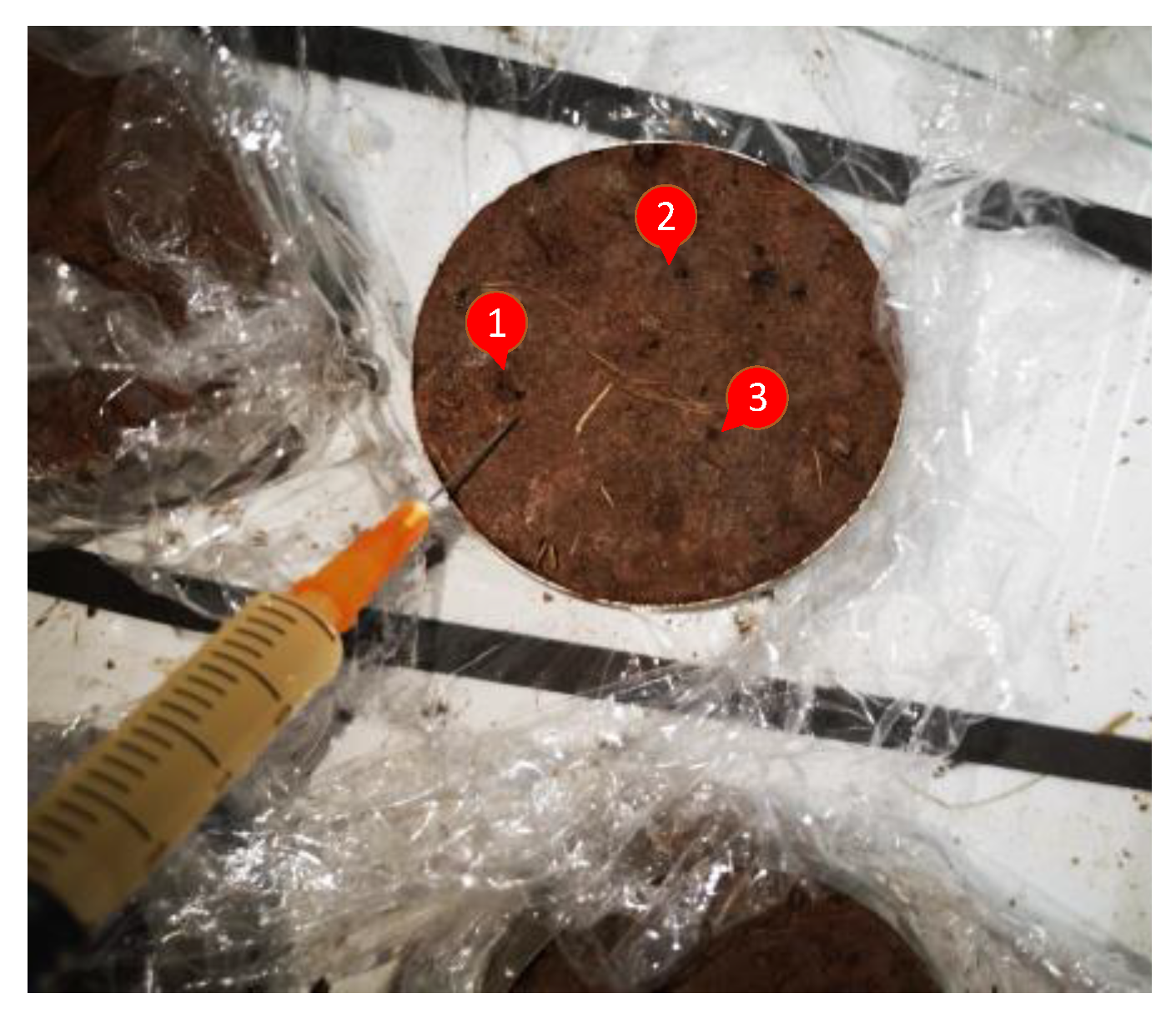
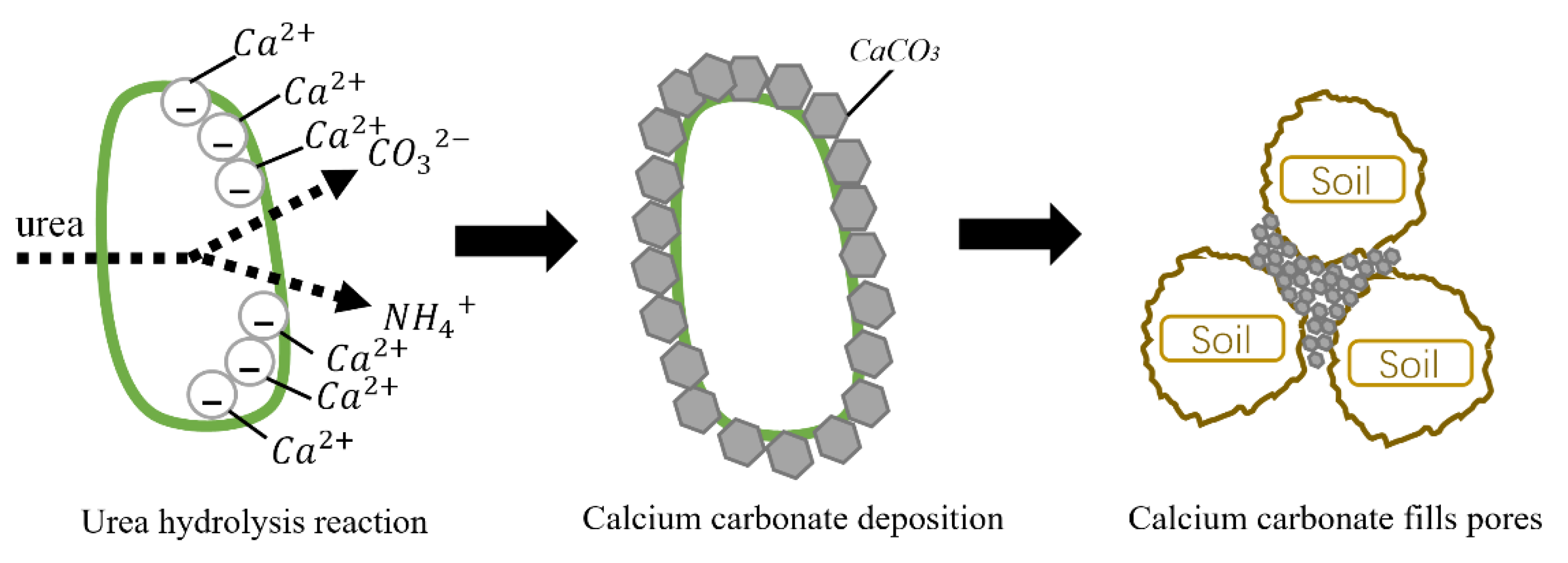
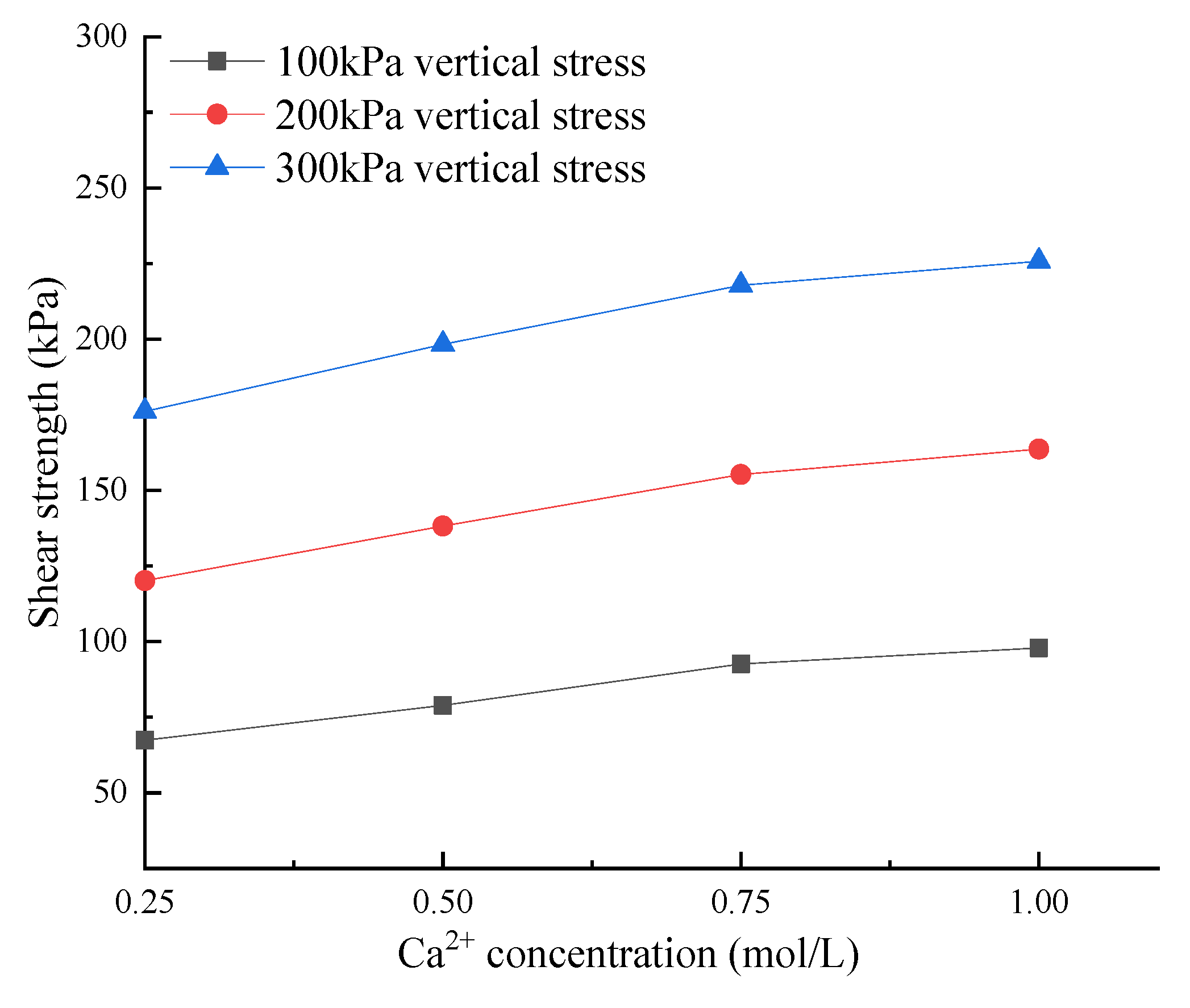
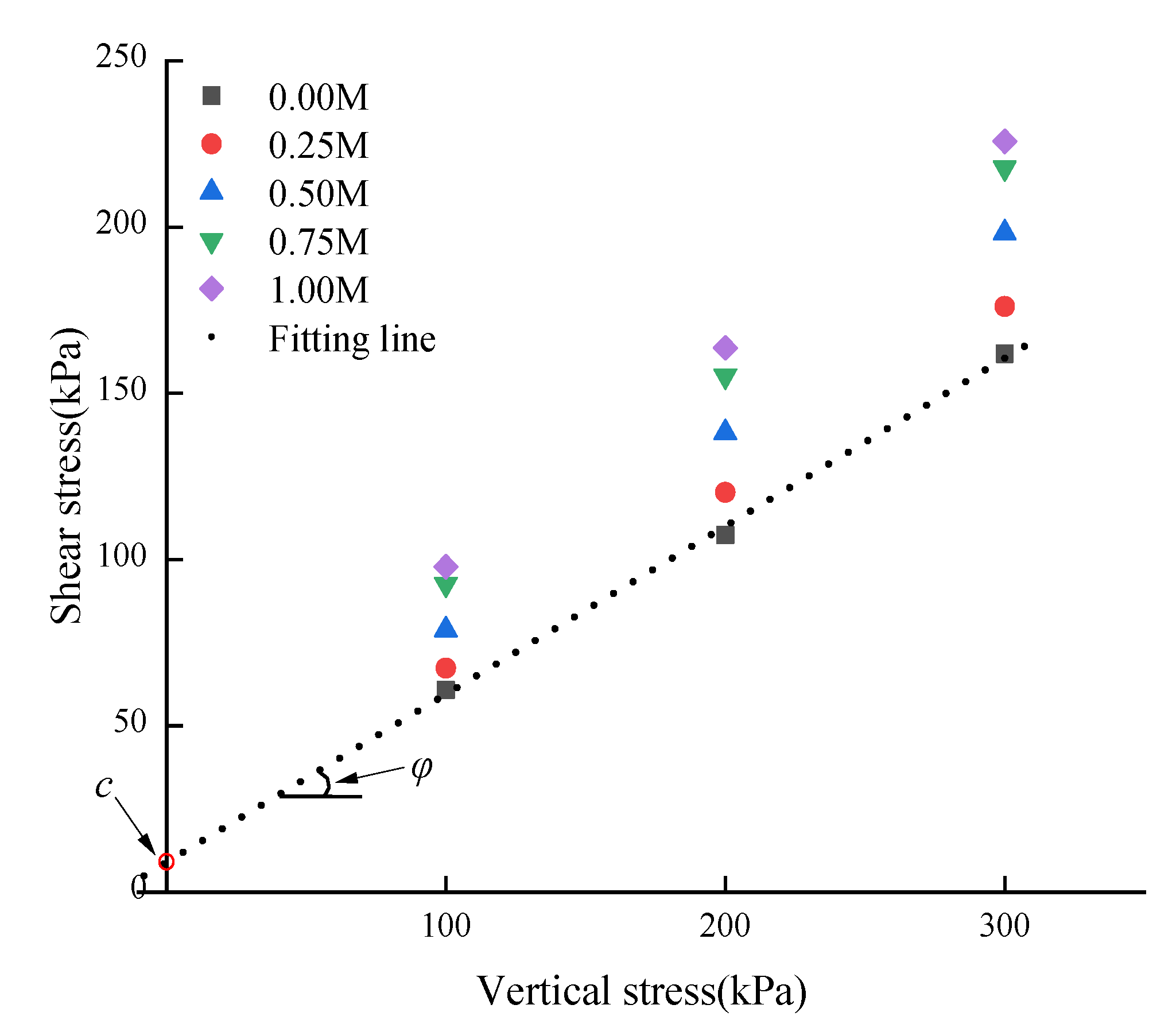

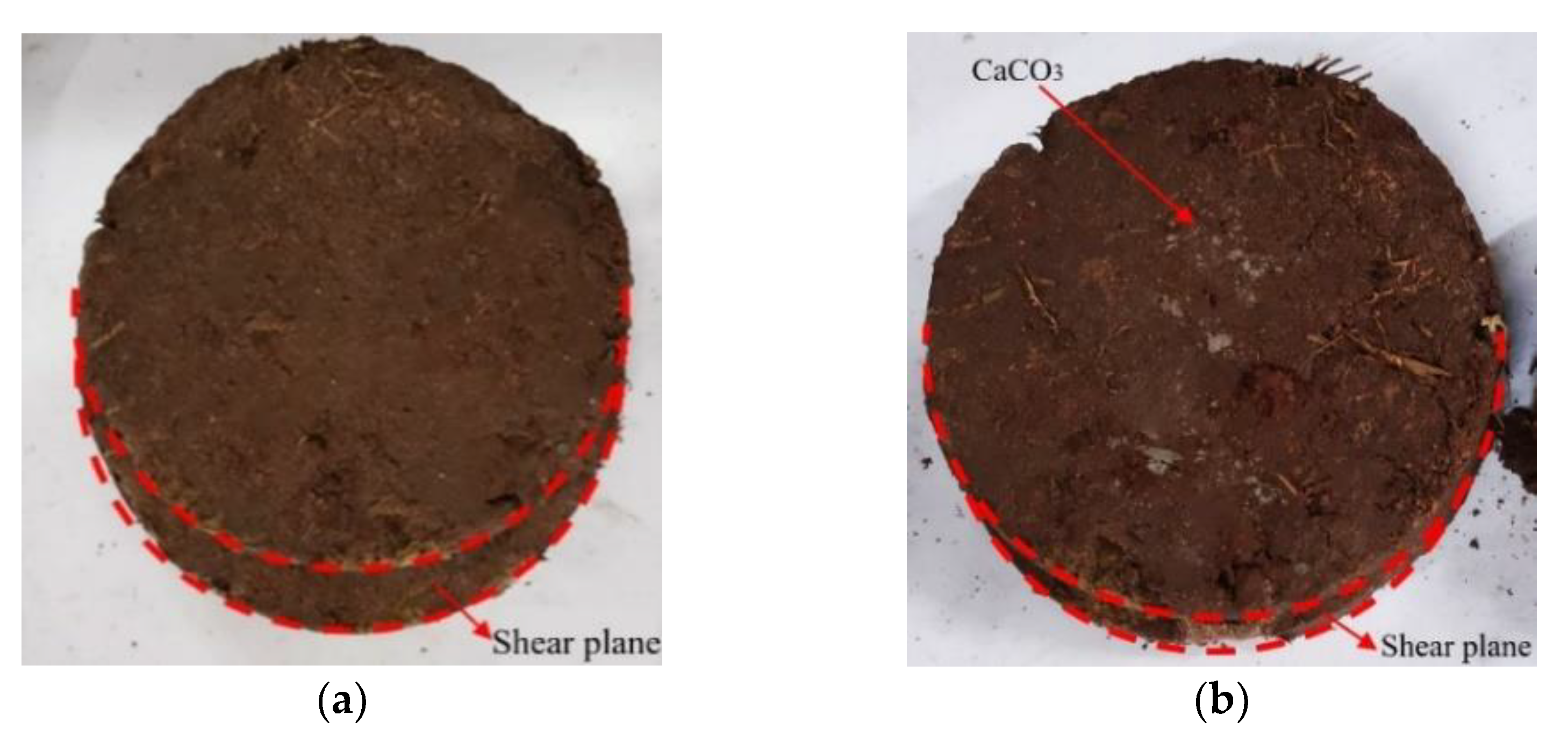
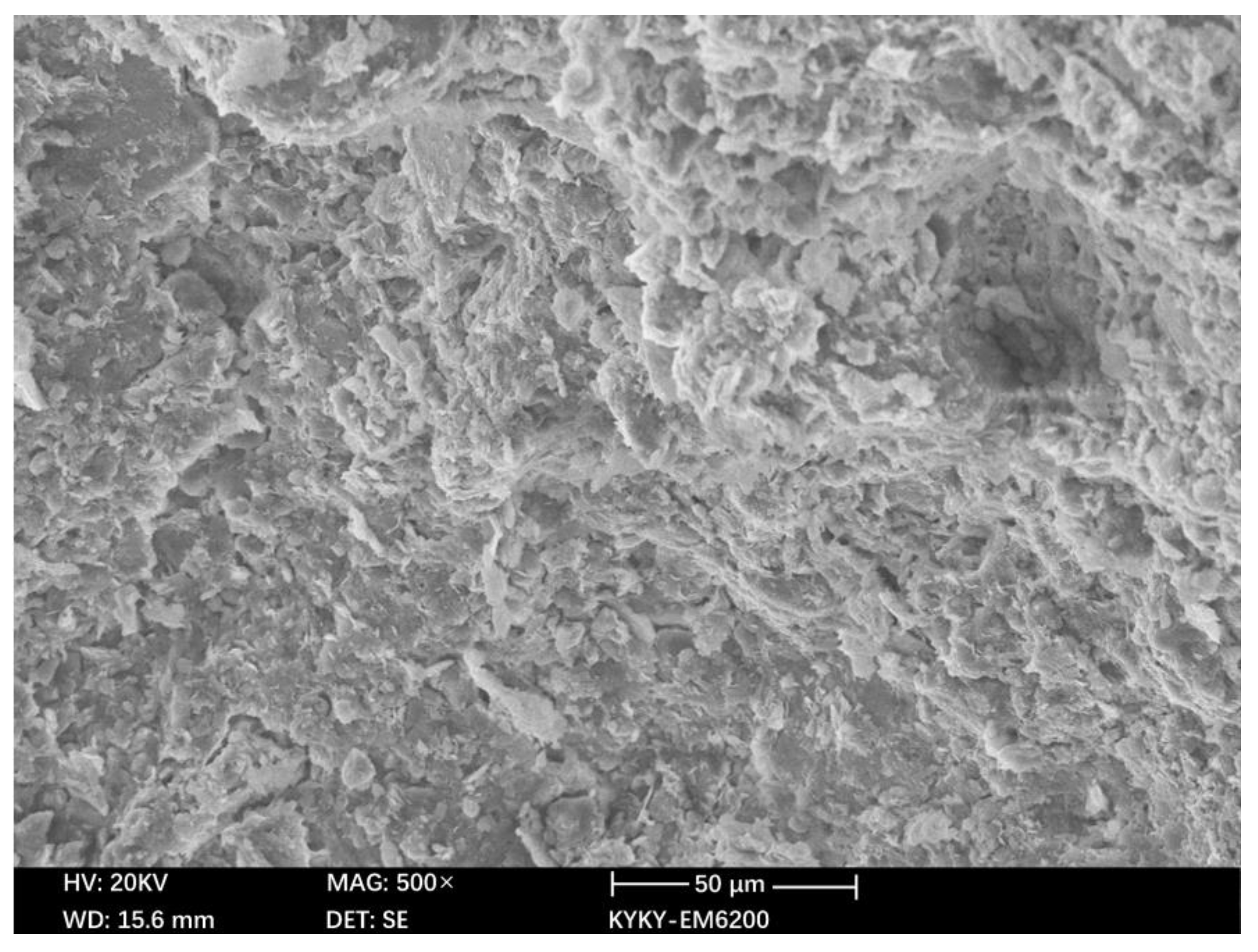
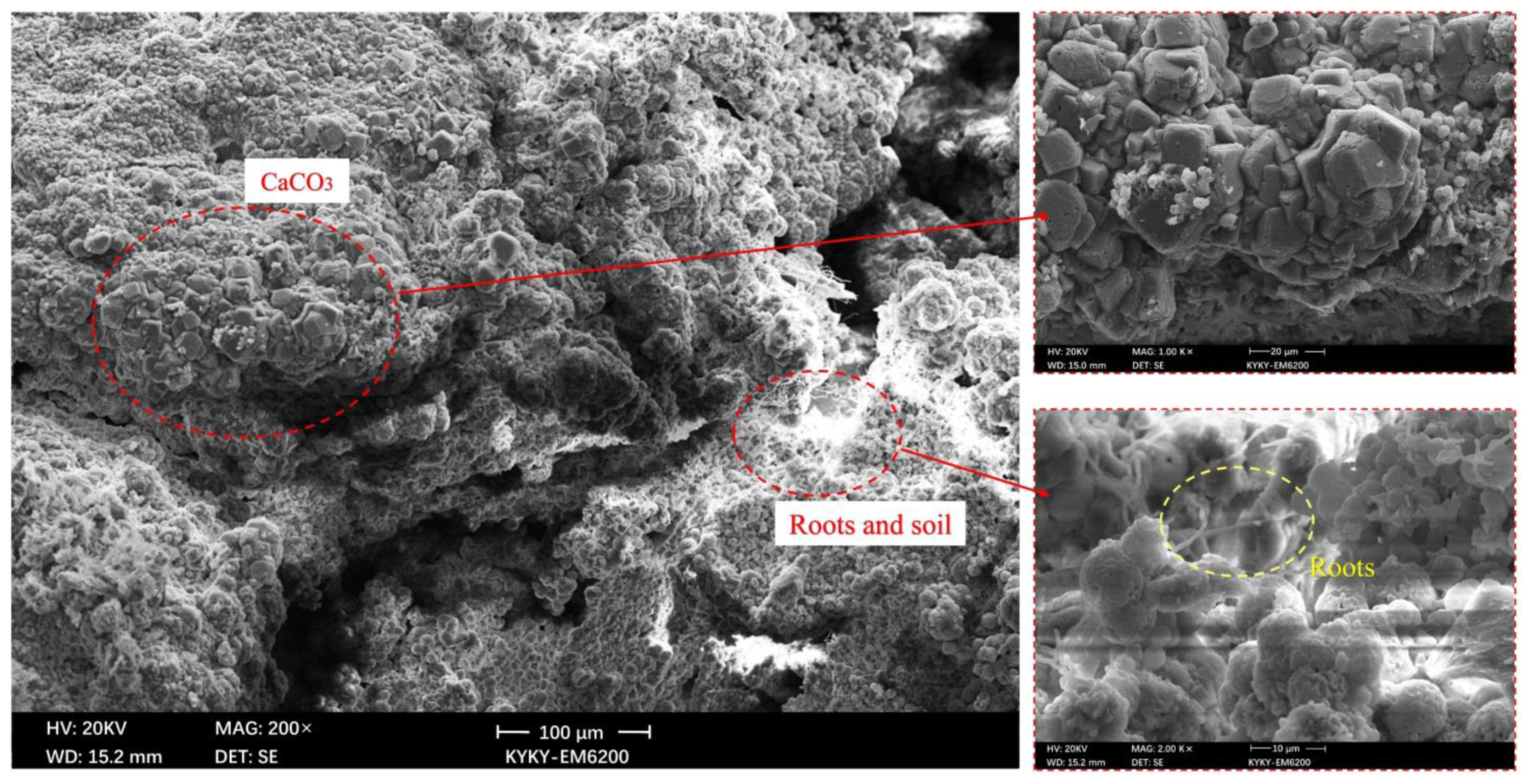
| Properties | Values |
|---|---|
| Density, ρ (g/cm3) | 1.91 |
| Moisture content, w (%) | 22 |
| Specific gravity, ds | 2.56 |
| Plastic limit, wP (%) | 19.2 |
| Liquid limit, wL (%) | 33.2 |
| Plasticity index, IP (%) | 14 |
| Liquidity index, IL | 0.2 |
| Concentration Number | CaCl2 Concentration /(mol L−1) | Urea Concentration /(mol L−1) | Number of Samples |
|---|---|---|---|
| 0.00 M | 0 | 0 | 3 |
| 0.25 M | 0.25 | 1 | 3 |
| 0.50 M | 0.50 | 1 | 3 |
| 0.75 M | 0.75 | 1 | 3 |
| 1.00 M | 1.00 | 1 | 3 |
| Concentration Number | c/(kPa) | φ/(°) |
|---|---|---|
| 0.00 M | 8.9 | 26.8 |
| 0.25 M | 12.5 | 28.5 |
| 0.50 M | 19.1 | 30.8 |
| 0.75 M | 30.1 | 32.0 |
| 1.00 M | 34.5 | 32.6 |
Publisher’s Note: MDPI stays neutral with regard to jurisdictional claims in published maps and institutional affiliations. |
© 2022 by the authors. Licensee MDPI, Basel, Switzerland. This article is an open access article distributed under the terms and conditions of the Creative Commons Attribution (CC BY) license (https://creativecommons.org/licenses/by/4.0/).
Share and Cite
Zheng, X.; Lu, X.; Zhou, M.; Huang, W.; Zhong, Z.; Wu, X.; Zhao, B. Experimental Study on Mechanical Properties of Root–Soil Composite Reinforced by MICP. Materials 2022, 15, 3586. https://doi.org/10.3390/ma15103586
Zheng X, Lu X, Zhou M, Huang W, Zhong Z, Wu X, Zhao B. Experimental Study on Mechanical Properties of Root–Soil Composite Reinforced by MICP. Materials. 2022; 15(10):3586. https://doi.org/10.3390/ma15103586
Chicago/Turabian StyleZheng, Xuegui, Xinyu Lu, Min Zhou, Wei Huang, Zhitao Zhong, Xuheng Wu, and Baoyun Zhao. 2022. "Experimental Study on Mechanical Properties of Root–Soil Composite Reinforced by MICP" Materials 15, no. 10: 3586. https://doi.org/10.3390/ma15103586







